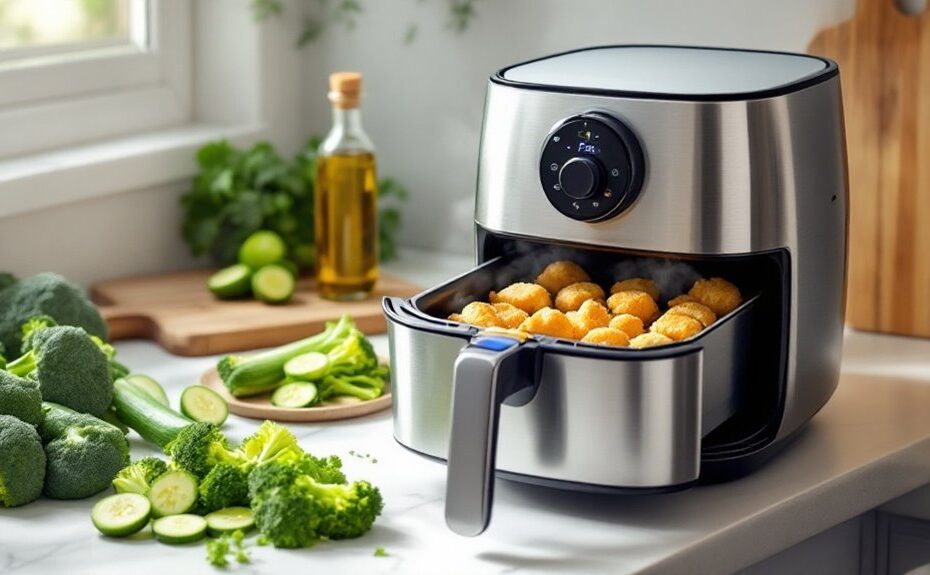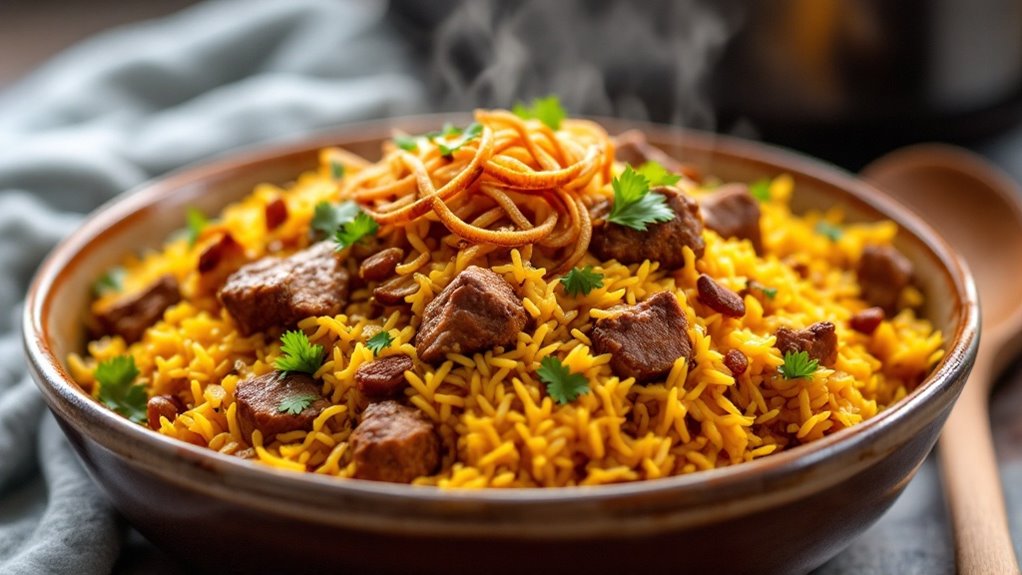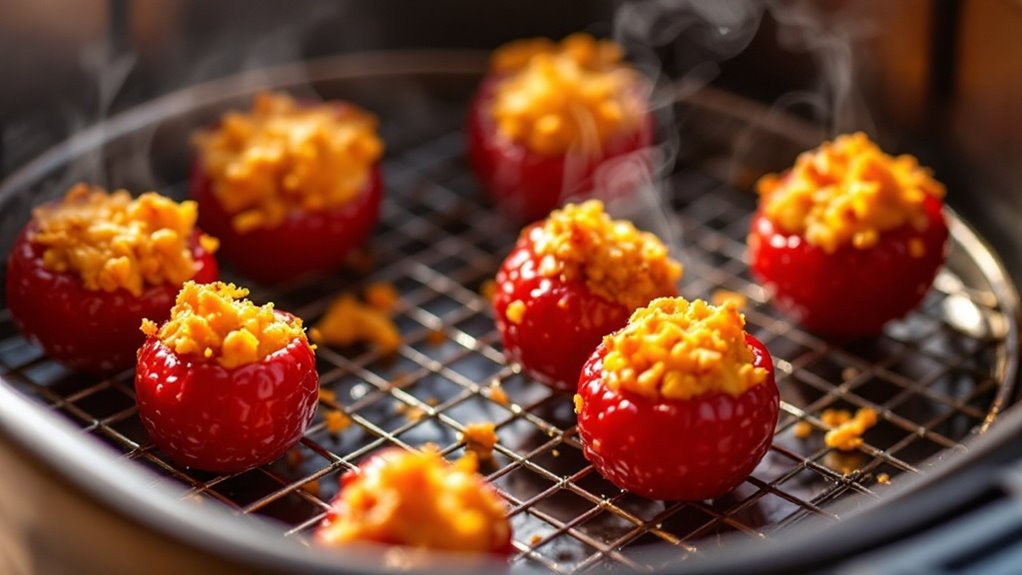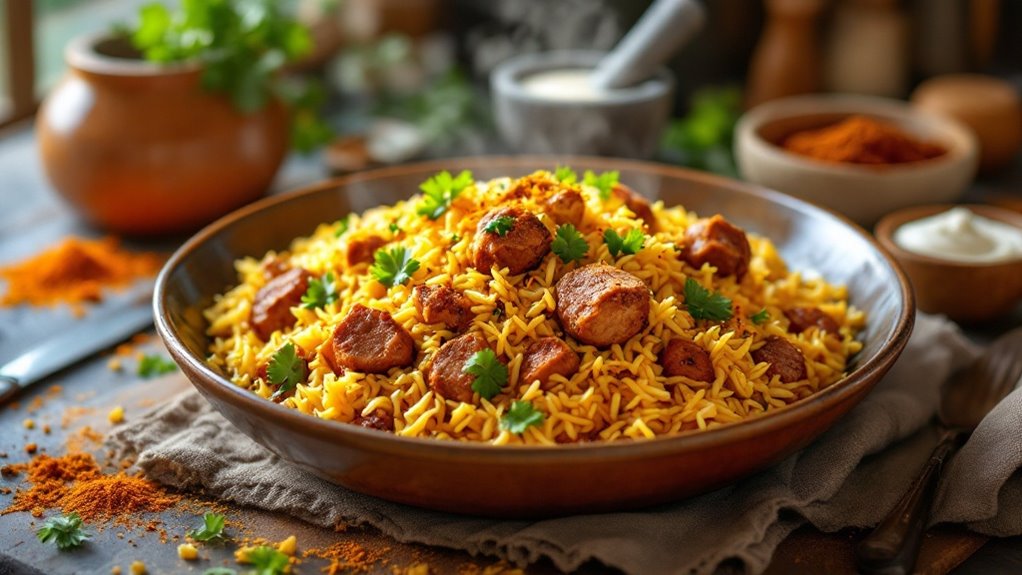You might not realize that an air fryer can be a game-changer for your low-carb diet, offering a way to enjoy crispy, flavorful meals without the extra carbs. By swapping traditional coatings for almond or coconut flour and focusing on lean proteins and non-starchy vegetables, you can create satisfying dishes that fit your dietary goals. But there's a catch—how you prepare and cook these ingredients can make or break your results. From preheating to avoiding common mistakes, mastering a few key techniques will reveal the full potential of your air fryer. Ready to transform your low-carb cooking?
Key Takeaways
- Choose low-carb ingredients like lean proteins, non-starchy vegetables, and almond or coconut flour for coatings.
- Preheat the air fryer to 350°F–400°F for even cooking and crispy results without added carbs.
- Use minimal oil with healthy fats like avocado or olive oil for a crispy, low-carb finish.
- Replace breadcrumbs with keto-friendly coatings like almond flour, crushed pork rinds, or Parmesan cheese.
- Avoid hidden carbs by checking labels and using sugar-free seasonings, herbs, and vinegar-based dressings.
Choose Low-Carb Ingredients
When selecting ingredients for a low-carb diet, focus on whole, unprocessed foods that are naturally low in carbohydrates. Opt for lean proteins like chicken, turkey, or fish, and incorporate non-starchy vegetables such as broccoli, zucchini, or cauliflower. For low carb snacks, choose nuts, seeds, or cheese, which provide satiety without spiking blood sugar. When preparing meals, consider ingredient substitutions like almond flour instead of wheat flour or cauliflower rice in place of traditional grains. These swaps reduce carb content while maintaining texture and flavor. Avoid processed foods high in added sugars or refined carbs, as they can derail your dietary goals. Prioritize fresh, nutrient-dense options to maximize health benefits and support your low-carb lifestyle effectively.
Preheat Your Air Fryer
Preheating your air fryer guarantees even cooking and crispier results, especially for low-carb recipes. Set the temperature to the ideal range of 350°F to 400°F, depending on the food, and allow 3-5 minutes for preheating. This step maximizes efficiency and helps maintain consistent texture and doneness.
Optimal Temperature Settings
To achieve the best results with your air fryer, it's essential to preheat it to the ideal temperature before cooking. Most air fryers perform best between 350°F and 400°F, but specific dishes may require adjustments. For low-carb recipes, precise temperature control tips guarantee even cooking and prevent overcooking delicate ingredients like vegetables or lean proteins. Lower temperatures (300°F–350°F) work well for reheating or dehydrating, while higher settings (375°F–400°F) are ideal for crisping. Energy efficiency considerations also play a role; avoid excessive preheating times to conserve energy. Always refer to your air fryer's manual for recommended settings and adjust based on the food's thickness and moisture content. Proper temperature management guarantees consistent results while maintaining the nutritional integrity of your low-carb meals.
Preheating Time Guidelines
Proper temperature settings are only effective if your air fryer is adequately preheated. Preheating benefits include even cooking, crispier results, and reduced cooking times. Most air fryers require 3–5 minutes to preheat, but check your model's manual for specifics. To save time, start preheating while you prep ingredients. Avoid overcrowding the basket, as this can extend cooking times and reduce efficiency. For low-carb recipes, preheating guarantees proteins and vegetables cook evenly without drying out. Use time-saving tips like setting a timer to avoid over-preheating, which wastes energy. If you're cooking multiple batches, keep the air fryer on between cycles to maintain temperature. Proper preheating maximizes your air fryer's performance, guaranteeing consistent results for your low-carb meals.
Use Minimal Oil for Cooking
When using an air fryer for low-carb cooking, opt for healthy oils like avocado or olive oil, which provide beneficial fats. Apply oil sparingly by lightly brushing or spraying it onto your food to achieve crispness without excess calories. This approach helps maintain a low-carb diet while enhancing texture and flavor.
Choose Healthy Oils
Since air fryers require minimal oil to achieve crispy results, choosing healthy oils is essential for maintaining a low-carb diet. Focus on oils with high smoke points and beneficial fats, such as avocado oil, extra virgin olive oil, or coconut oil. These options provide healthy oil benefits, including anti-inflammatory properties and support for heart health. When considering oil selection tips, avoid refined or hydrogenated oils, as they often contain unhealthy trans fats. Opt for cold-pressed or unrefined varieties to preserve nutrients. Additionally, make sure your oil choice aligns with your dietary goals by checking labels for purity and avoiding added sugars or fillers. By selecting the right oils, you'll enhance flavor while keeping your meals low-carb and nutrient-dense.
Apply Oil Sparingly
Air fryers are designed to cook food with substantially less oil than traditional frying methods, making them ideal for a low-carb diet. To maximize their benefits, apply oil sparingly. Use a light coating to enhance texture and crispiness without adding unnecessary calories or carbs. For effective oil application tips, consider using spray oil techniques. A fine mist guarantees even distribution while minimizing excess. Opt for an oil sprayer or a store-bought spray oil with no added propellants. Avoid drizzling or brushing, as these methods often lead to overuse. Pairing minimal oil with high-heat cooking in the air fryer achieves a crispy finish while keeping your meals low-carb and healthy. This approach supports your dietary goals without compromising flavor or texture.
Opt for Keto-Friendly Coatings
To keep your low-carb meals flavorful without compromising your diet, choose keto-friendly coatings for air-fried foods. Traditional breadcrumbs are high in carbs, so opt for keto breading options like almond flour, crushed pork rinds, or coconut flour. These alternatives provide a crispy texture while keeping carb counts low. Enhance the flavor by using low carb seasoning blends, such as garlic powder, smoked paprika, or Italian herbs, which add depth without added sugars. You can also mix grated Parmesan cheese or nutritional yeast into your coatings for a savory, umami-rich crust. Always check labels on pre-made seasonings to avoid hidden carbs. By selecting these coatings, you'll maintain the crunch and taste you crave while staying aligned with your low-carb or keto goals.
Cook Vegetables to Perfection
While air fryers are often associated with cooking proteins, they're equally effective for preparing low-carb vegetables with a perfect texture. To achieve this, start by cutting vegetables into uniform sizes for even cooking. Toss them lightly in olive oil and apply your preferred vegetable seasoning, such as garlic powder, paprika, or Italian herbs. Preheat the air fryer to 375°F (190°C) and arrange the vegetables in a single layer to guarantee crispness. Cooking times vary: zucchini and bell peppers take 8-10 minutes, while denser options like broccoli or cauliflower need 12-15 minutes. Shake the basket halfway through to promote even browning. The air fryer's rapid circulation creates a caramelized exterior while keeping the interior tender, making it ideal for low-carb vegetable dishes. Adjust seasoning and cooking times based on your preferences.
Make Crispy Low-Carb Proteins
Since air fryers excel at creating a crispy exterior without excessive oil, they're a game-changer for preparing low-carb proteins like chicken, fish, or tofu. Start by patting your protein dry to guarantee even crisping. Use protein seasoning tips like combining herbs, spices, and salt-free blends to enhance flavor without added carbs. For marinating techniques, opt for low-carb options like olive oil, lemon juice, or vinegar-based mixtures, and let the protein soak for at least 30 minutes. Preheat your air fryer to 375°F for the best results, then cook in a single layer, flipping halfway through. Chicken wings, salmon fillets, or tofu cubes typically take 12-18 minutes, depending on thickness. Avoid overcrowding to maintain crispiness and guarantee even cooking.
Avoid High-Carb Air Fryer Mistakes
Air fryers are a powerful tool for low-carb cooking, but certain mistakes can unintentionally increase carb intake. Avoid breading proteins or vegetables with high-carb coatings like flour or breadcrumbs. Instead, opt for low-carb alternatives such as almond flour or crushed pork rinds. Be mindful of pre-packaged frozen foods, as many contain hidden carbs; always check labels and use carb counting tips to stay on track. Overloading the air fryer basket can lead to uneven cooking, prompting you to add extra oil or sauces, which may increase carb content. Practice portion control strategies to avoid overeating, even with low-carb options. Finally, skip sugary marinades or glazes, as they can quickly derail your carb goals. Stick to herbs, spices, and vinegar-based dressings for flavor without the carbs.
Experiment With Low-Carb Recipes
To maximize the benefits of your air fryer on a low-carb diet, experimenting with creative recipes can keep meals exciting and aligned with your goals. Try making low-carb snacks like crispy zucchini chips or almond flour-coated chicken tenders, which are quick, satisfying, and nutrient-dense. For air fryer desserts, consider options like keto-friendly cheesecake bites or cinnamon-dusted avocado fries, which provide a sweet treat without spiking your carb intake. Use low-carb flours, such as almond or coconut, to create crunchy coatings or batters. Incorporate spices, herbs, and healthy fats to enhance flavor while keeping carbs minimal. By exploring diverse recipes, you'll discover how versatile your air fryer can be for maintaining a low-carb lifestyle without sacrificing taste or variety.
Clean Your Air Fryer Regularly
While maintaining a low-carb diet with your air fryer, it's essential to clean the appliance regularly to secure peak performance and food safety. Proper air fryer maintenance prevents grease buildup, which can affect cooking efficiency and create unpleasant odors. Follow cleaning frequency tips by wiping the basket and tray after each use with warm, soapy water or a non-abrasive sponge. For deeper cleaning, remove any food residue weekly and check the heating element for debris. Avoid using harsh chemicals or metal scrubbers, as they can damage non-stick surfaces. Regular cleaning confirms your air fryer operates effectively, maintains food quality, and reduces the risk of cross-contamination. By prioritizing cleanliness, you'll extend the appliance's lifespan and support your low-carb cooking goals.
Disclosure: As an Amazon Associate, I earn from qualifying purchases.



